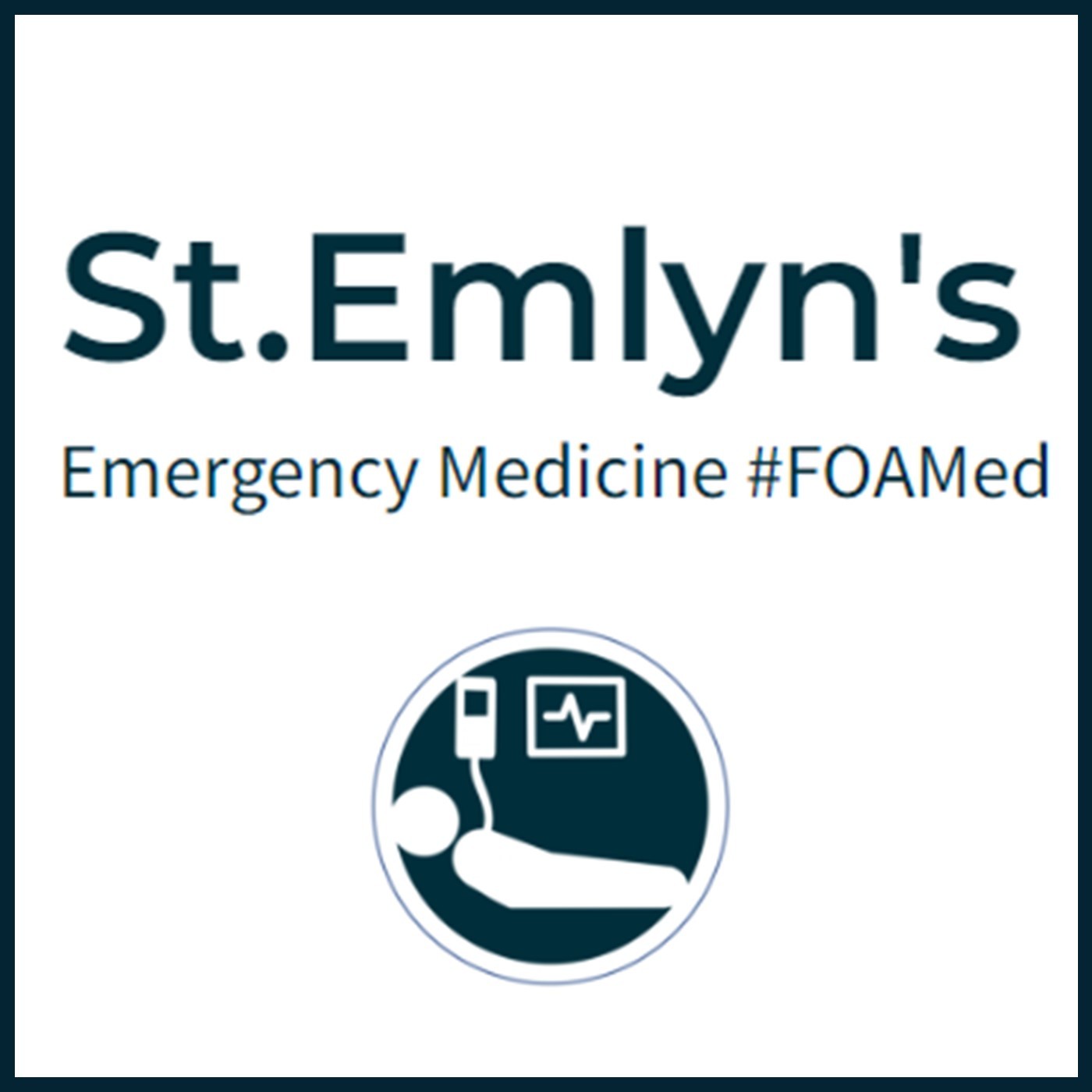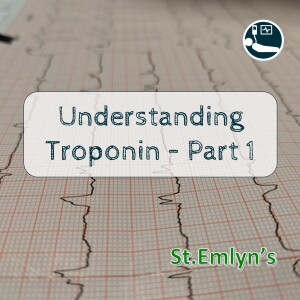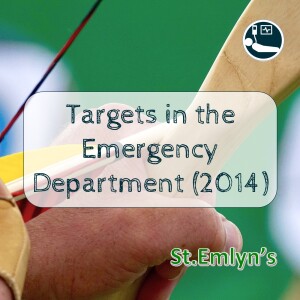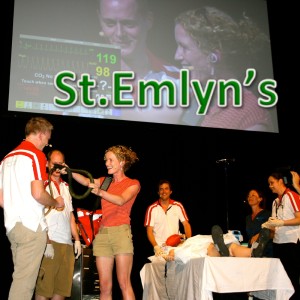
1.3M
Downloads
273
Episodes
A UK based Emergency Medicine podcast for anyone who works in emergency care. The St Emlyn ’s team are all passionate educators and clinicians who strive to bring you the best evidence based education. Our four pillars of learning are evidence-based medicine, clinical excellence, personal development and the philosophical overview of emergency care. We have a strong academic faculty and reputation for high quality education presented through multimedia platforms and articles. St Emlyn’s is a name given to a fictionalised emergency care system. This online clinical space is designed to allow clinical care to be discussed without compromising the safety or confidentiality of patients or clinicians.
Episodes

Sunday Jul 27, 2014
Ep - 11 Understanding Troponin Part 1
Sunday Jul 27, 2014
Sunday Jul 27, 2014
The Ultimate Guide to Understanding Troponins in Emergency Medicine
Welcome to the St. Emlyn's podcast! In this episode, we're exploring the fascinating world of troponins, vital biomarkers essential for diagnosing myocardial injury. Whether you're a seasoned clinician or a medical student, understanding troponins is crucial for effective patient care. We'll cover everything from the basics to advanced concepts, ensuring you have a comprehensive grasp of this critical topic.
What are Troponins?
Troponins are proteins found in muscle tissue, playing a key role in muscle contraction. Often misunderstood as cardiac enzymes, troponins are actually proteins involved in the contractile apparatus within muscle cells. They exist in three forms: Troponin I, Troponin T, and Troponin C, which work together within muscle fibers to regulate muscle contractions.
Why are Troponins Important in Cardiology?
Troponins are crucial biomarkers for diagnosing myocardial injury. When heart muscle is damaged, troponins are released into the bloodstream. This release can occur due to various conditions, including myocardial infarction (heart attack) and other forms of stress on the heart. Measuring troponin levels in the blood helps clinicians determine the extent of myocardial injury and make informed decisions about patient care.
The Difference Between Cardiac and Skeletal Troponins
Troponins are present in both skeletal and cardiac muscle. However, cardiac-specific isoforms of Troponin I and Troponin T can be detected through blood tests, allowing clinicians to specifically identify myocardial damage. This specificity is a significant advancement over previous markers like CK, LDH, and ALT, which were not cardiac-specific and took longer to rise in the bloodstream.
When are Troponins Released into the Blood?
Troponins are released into the bloodstream when there is myocardial injury. This injury can result from various causes, such as acute myocardial infarction, physical stress, or other conditions that strain the heart. Understanding that troponins indicate myocardial injury rather than just myocardial infarction is crucial for accurate diagnosis and treatment.
The Kinetics of Troponin Release
Following myocardial injury, troponin levels typically peak in the blood within 12 to 24 hours. The time it takes for troponin levels to fall depends on several factors, including the severity of the injury, the patient's renal function, and whether there is ongoing troponin release into the blood. For example, patients with significant myocardial infarction might take weeks to clear troponins from their bloodstream, while those with smaller injuries might clear them within a day.
Troponins and Renal Failure
A common question is whether troponin tests are useful in patients with renal failure. The answer is a resounding yes. Although patients with renal failure may have elevated baseline troponin levels due to reduced clearance, troponin testing remains a valuable diagnostic tool. It's essential to interpret these levels in the context of the patient's renal function and look for trends in troponin levels through serial testing.
Understanding Troponin Assays
Troponin tests are immunoassays, which means they use antibodies to target specific parts of the troponin molecule. These antibodies are attached to a signal that emits light, allowing for the quantification of troponin levels in the blood. While lab-based assays are highly accurate, point-of-care testing devices are also available, though they may not be as sensitive or precise as lab tests.
The Role of Point-of-Care Testing
Point-of-care testing devices, such as handheld analyzers, offer quick results and can be used at the bedside. However, they may not match the sensitivity and precision of lab-based assays. Some portable devices provide qualitative results, similar to a home pregnancy test, while others offer quantitative measurements. Clinicians should be aware of these differences and use point-of-care devices appropriately.
Analytical vs. Diagnostic Sensitivity
When discussing troponin assays, it's crucial to differentiate between analytical sensitivity and diagnostic sensitivity. Analytical sensitivity refers to the assay's ability to detect low concentrations of troponin reliably. In contrast, diagnostic sensitivity pertains to the assay's ability to correctly identify patients with the condition being tested for, such as acute myocardial infarction. High-sensitivity troponin assays have improved both analytical and diagnostic sensitivity, enabling earlier and more accurate diagnosis.
Timing of Troponin Testing
In the UK, troponin testing typically starts from the time of symptom onset. This approach differs from other countries where testing begins upon the patient's arrival in the emergency department. The timing of troponin testing is crucial, as early testing can lack sensitivity. Serial sampling over several hours helps ensure accurate diagnosis, with a common practice being to test initially and then again at intervals such as six, ten, or twelve hours after symptom onset.
Interpreting Troponin Levels in Clinical Practice
Interpreting troponin levels requires considering the clinical context and pre-test probability. A positive troponin test in a patient with low pre-test probability of myocardial infarction may not indicate a true positive. Conversely, a negative test in a high-risk patient does not entirely rule out disease, especially if there is potential for a late troponin rise. Clinicians must integrate troponin results with other diagnostic information to make informed decisions.
Troponins in Renal Failure
Patients with renal failure often have elevated baseline troponin levels due to impaired clearance. However, troponin testing remains valuable for diagnosing myocardial injury in these patients. It's essential to understand the baseline level for each patient and focus on changes in troponin levels over time, rather than a single measurement. Serial sampling helps differentiate chronic elevation from acute myocardial injury.
Diagnosing Unstable Angina
It's important to recognize that unstable angina can occur without elevated troponin levels. These patients may not show a rise and fall in troponin but still have significant coronary artery disease that requires attention. Clinical judgment, along with other diagnostic tools like ECG and patient history, is vital in diagnosing and managing unstable angina.
Key Takeaways for Clinicians
- Troponins are proteins involved in muscle contraction and are critical biomarkers for diagnosing myocardial injury.
- Cardiac-specific isoforms of Troponin I and Troponin T are used to detect myocardial damage through blood tests.
- Troponins are released into the blood following myocardial injury, not just myocardial infarction.
- The timing of troponin testing is crucial, with serial sampling providing more accurate results.
- Point-of-care testing devices offer quick results but may lack the sensitivity and precision of lab-based assays.
- Interpreting troponin levels requires considering the clinical context and pre-test probability.
- Troponin testing is valuable in patients with renal failure, focusing on changes in levels over time.
- Unstable angina can occur without elevated troponin levels, requiring careful clinical evaluation.
Conclusion
Understanding troponins and their role in diagnosing myocardial injury is essential for clinicians. From the basics of what troponins are to the nuances of interpreting test results, this knowledge is crucial for providing the best care to patients with suspected cardiac conditions. Stay tuned for our next episode, where we'll delve deeper into high-sensitivity troponin assays and their impact on emergency medicine.
For any questions or further discussion, feel free to comment on the blog post or email us. We're here to help and look forward to continuing this conversation. Until next time, take care and keep learning!
This blog post is brought to you by the team at St. Emlyn's, dedicated to providing high-quality education and resources for emergency medicine professionals.

Monday Jul 21, 2014
Ep 10 - Intro to EM: Staying safe in your first job
Monday Jul 21, 2014
Monday Jul 21, 2014
Starting Your Career in Emergency Medicine: Key Insights from St. Emlyn’s
Welcome to the world of emergency medicine! At St. Emlyn’s, we understand the challenges and excitement that come with starting your career in this fast-paced field. Whether you’re a new doctor stepping into the emergency department (ED) for the first time or a medical student gearing up for your rotation, we’ve got you covered. This post delves into the nuances of emergency medicine, sharing valuable insights from seasoned professionals, Iain Beardsell and Simon Carley, to help you navigate your journey effectively.
Understanding the Unique Nature of Emergency Medicine
Emergency medicine is distinct from other medical disciplines. Unlike the traditional approach taught in medical school, which involves extensive histories and comprehensive examinations, emergency medicine requires quick, focused thinking and decisive action. The goal is to identify and address life-threatening conditions promptly.
Time-Pressured Environment
In the ED, time is of the essence. Patients arrive needing immediate care, and as an emergency physician, you won’t have the luxury of lengthy deliberations. Your patients want answers quickly, and this urgency shapes the way you practice. You’ll learn to focus on the presenting problem and drill down into the most critical aspects of their condition.
Different Thinking Model
The thinking model in emergency medicine is primarily hyperthetico-deductive reasoning. This means you’ll form hypotheses based on initial information and then test these hypotheses through targeted questions and examinations. For instance, if a 55-year-old man presents with central crushing chest pain radiating down his left arm, your first thought should be an acute myocardial infarction (AMI).
Prioritizing Life-Threatening Conditions
One of the fundamental differences in emergency medicine is the approach to diagnosing and treating conditions. Instead of trying to confirm what a patient has, you’ll focus on ruling out what they don’t have, especially the most life-threatening possibilities. For example, with chest pain, you’ll consider AMI, pulmonary embolism (PE), and aortic dissection as top priorities.
The 10% Rule
Interestingly, about 10% of patients presenting with symptoms like chest pain or headache have significant pathology. Your job is to identify this 10% while efficiently managing the remaining 90%. This approach ensures that you don’t miss critical diagnoses while not overburdening yourself with unnecessary details.
Practical Steps for Your First Shift
As you prepare for your first shift in the ED, here are some practical steps and philosophies to keep in mind:
Resuscitation First
Your primary goal is to identify if a patient needs resuscitation. Are they critically unwell? Do they require urgent interventions to save their life? This is your top priority.
Pain Management
After ensuring resuscitation, your next focus should be pain management. A pain-free emergency department is a goal to strive for. Administer analgesia as needed to ensure patient comfort, even before completing a full history or examination.
Rule Out Life-Threatening Conditions
When a patient presents with a complaint, think about the worst-case scenarios related to their symptoms and aim to rule these out. For example, with chest pain, consider whether the patient might have an AMI, PE, or aortic dissection.
Focused History and Examination
Conduct a focused history and examination to gather information pertinent to the presenting complaint. Avoid getting bogged down with irrelevant past medical history unless it directly impacts the current situation.
Implementing the Four Big Hitters
Simon and Iain emphasize the importance of considering four key interventions for every patient:
- Oxygen: Determine if the patient needs oxygen or airway support.
- Analgesia: Ensure adequate pain relief is provided.
- Fluids: Assess if the patient would benefit from intravenous fluids.
- Antibiotics: Consider if antibiotics are necessary for their condition.
Learning and Growing in the ED
The ED is a dynamic learning environment. Here’s how you can maximize your growth and effectiveness:
Ask Questions
Don’t hesitate to ask questions. No question is too silly. Engaging with senior colleagues and seeking their advice will enhance your learning and patient care skills.
Continuous Learning
Emergency medicine is a field where continuous learning is crucial. Keep up with the latest practices, guidelines, and innovations. Attend workshops, conferences, and training sessions to stay updated.
Collaborative Approach
Remember that emergency medicine is a team effort. Collaborate with nurses, paramedics, and other healthcare professionals. Effective communication and teamwork are essential for providing the best patient care.
Reflect and Improve
After each shift, take time to reflect on your experiences. Identify what went well and areas for improvement. This self-assessment will help you grow as a clinician and enhance your skills over time.
The Importance of Confidence and Competence
Confidence in your abilities is vital, but it must be balanced with competence. Strive to be competent in your practice, and your confidence will naturally follow. Be aware of the balance between these two aspects to avoid the pitfalls of overconfidence.
Unconscious Incompetence
One of the dangers in any medical field is unconscious incompetence—being unaware of what you don’t know. Stay humble, keep learning, and seek feedback from peers and seniors to continuously improve your competence.
Embracing the ED Culture
The culture in the ED is unique. It’s a place where decisive actions and quick thinking are valued. Embrace this culture and the opportunities it presents for hands-on learning and making a real difference in patients’ lives.
A Little Less Conversation, A Little More Action
In the ED, the Elvis philosophy—“a little less conversation, a little more action”—applies. Focus on doing what’s necessary for the patient rather than getting caught up in lengthy discussions. This action-oriented approach is crucial for effective emergency care.
Conclusion: Your Journey Ahead
Starting your career in emergency medicine is both exciting and challenging. At St. Emlyn’s, we believe in providing you with the tools, knowledge, and support you need to succeed. Remember the key principles: prioritize life-threatening conditions, focus on critical interventions, continuously learn and ask questions, and embrace the dynamic culture of the ED.
We love our jobs and hope that you, too, will find the same passion and fulfillment in your career. Good luck, enjoy the journey, and know that we’ll be with you every step of the way through this podcast and our wider St. Emlyn’s community.
Welcome to the world of emergency medicine. Let’s make a difference together!

Thursday Jul 17, 2014
Ep 9 - Targets in the Emergency Department (2014)
Thursday Jul 17, 2014
Thursday Jul 17, 2014
Navigating the Challenges and Benefits of Targets in Emergency Medicine: A Deep Dive from St. Emlyn's
Welcome back to the St. Emlyn's blog. Today, we're tackling a topic that's both crucial and controversial in the UK: the multitude of targets faced by emergency departments (EDs). As many of you know, our emergency services have become world leaders in setting and striving to meet various targets. This post explores the impact of these targets, drawing insights from a recent St. Emlyn's podcast discussion between Iain Beardsell and Simon Carley.
Understanding the Four-Hour Access Target
The four-hour access target is perhaps the most well-known and influential benchmark in UK emergency medicine. This target mandates that 95% of patients must be admitted, transferred, or discharged within four hours of arrival at the ED. Although some argue that this system forces a "clipboard mentality," there are substantial benefits.
Historical Context and Improvements
Before the introduction of the four-hour target, UK EDs often experienced chaotic conditions with patients waiting for days. The target has driven significant improvements by making timely patient management a priority across the entire healthcare system. It has led to increased staffing levels and has enhanced the efficiency of associated services, like radiology and laboratory testing, which are critical for patient care.
Benefits of the Four-Hour Target
- Improved Patient Flow: The four-hour target encourages EDs to streamline processes, reducing overcrowding and improving overall patient flow.
- Increased Staffing: The target has justified the hiring of more staff, including senior consultants, which enhances the quality of care.
- Enhanced Diagnostics and Protocols: The pressure to meet the target has fostered innovations in protocols and diagnostics, benefiting patient outcomes.
Challenges and Criticisms
However, the four-hour target is not without its drawbacks. One major issue is the pressure it places on clinicians, potentially leading to rushed or suboptimal decision-making, particularly during peak times when the ED is overwhelmed. This can sometimes result in junior doctors making hasty decisions under pressure.
Other Quality Indicators and Targets
Beyond the four-hour target, UK EDs face a plethora of additional quality indicators, including metrics for:
- The time it takes to see a senior decision-maker
- The recording of vital signs upon patient arrival
- The percentage of patients leaving before being seen
These targets aim to ensure comprehensive and timely care but also add to the administrative burden on clinicians.
Balancing Targets and Clinical Care
Achieving a balance between meeting targets and providing high-quality clinical care requires strong clinical leadership and effective management. It's crucial that the focus remains on patient care rather than merely ticking boxes. At St. Emlyn's, we advocate for using targets to enhance clinical processes rather than allowing them to dictate every action.
Financial Penalties and National Standards
In recent years, new targets linked to financial penalties have been introduced. For example, failing to complete VT risk assessments or properly signposting psychological services can result in financial consequences for hospitals. These measures, while well-intentioned, further complicate the landscape of clinical priorities and administrative tasks.
The Role of Clinical Leadership
Effective clinical leadership is vital in navigating these challenges. Leaders must prioritize direct patient care while managing the increasing number of bureaucratic processes. It's essential to prevent the overburdening of clinicians with administrative tasks, ensuring they can focus on what matters most: the patients.
Trauma Team Targets
Recently, trauma team targets have been established, such as the requirement for a consultant to see major trauma patients within five minutes of arrival and for these patients to reach CT within 30 minutes. While these targets aim to standardize care and improve outcomes, they can be challenging to meet consistently, especially for cases that do not follow the typical major trauma profile.
Real-World Implications
For instance, elderly patients who suffer injuries but present later with complications might not meet the consultant within the stipulated five minutes, potentially resulting in penalties despite receiving appropriate care. Additionally, the 30-minute CT target can push teams to rush procedures, which might compromise safety.
Learning from Experience
The UK healthcare system has learned valuable lessons from past experiences, such as the mid-staff inquiry, emphasizing the importance of clinical judgment over rigid adherence to targets. The goal is to use targets to support and improve patient care rather than let them drive clinical decisions.
Future Directions
Looking forward, increasing the number of consultants and ensuring they are actively involved in patient care decisions will be critical. This shift will help balance the need to meet targets with the imperative to provide high-quality, individualized patient care.
Conclusion: A Thought-Provoking Discussion
The discussion around targets in emergency medicine is complex and multifaceted. While they bring about improvements in efficiency and care standards, they also introduce significant challenges. At St. Emlyn's, we believe that with wise and flexible application, targets can be a powerful tool to enhance clinical care.
Your Thoughts?
We'd love to hear how targets impact your practice. Do they help you deliver better care, or do they create more hurdles than they're worth? Share your experiences with us, and let's continue this important conversation.
For more insights and discussions, keep following the St. Emlyn's blog. Your feedback is invaluable to us as we navigate the ever-evolving landscape of emergency medicine together.

Tuesday Jul 08, 2014
Ep 8 - Trauma Team Leadership
Tuesday Jul 08, 2014
Tuesday Jul 08, 2014
Welcome to the St. Emlyn's podcast, where today we delve into the critical realm of trauma teams and trauma team leadership. Our focus is on optimizing efficiency and patient outcomes in the resuscitation room. Drawing from a hypothetical trauma case, we'll equip you with actionable knowledge to enhance your practice.
Understanding the Modern Trauma System
The UK has undergone significant reorganization in trauma services, emphasizing major trauma centres. These centres bypass local hospitals to ensure that patients with severe injuries receive specialized care. For instance, London has four major trauma centres, while Manchester has three. Along the South Coast, centres extend from Bristol to Brighton and down to Plymouth, ensuring a wide geographic spread.
The Importance of Trauma Team Leadership
Effective trauma team leadership is crucial for managing severe trauma cases. It's about making quick, informed decisions to optimize patient outcomes. One ambitious yet beneficial target is getting major trauma patients into a CT scanner within 30 minutes of arrival. Meeting this target can significantly improve patient outcomes.
Optimizing Team Dynamics
Efficient trauma team dynamics are key. Clear, structured communication is critical. Use first names to foster a collaborative environment and break down hierarchical barriers. For instance, instruct the anesthetist to manage both airway and analgesia, leveraging their skills in pain management.
Concurrent Activity and Task Allocation
In high-pressure environments, concurrent activity is vital. As the trauma team leader, ensure multiple tasks are performed simultaneously. For example, while one team member inserts a chest drain, another applies a pelvic binder, and a third prepares for intravenous access. This approach minimizes delays and streamlines patient management.
Packaging for Transport
Before transporting the patient to the CT scanner, ensure they are appropriately packaged. Use portable monitors and verify that all necessary equipment, such as oxygen and rescue medications, are in place. A pre-transport checklist can prevent any oversights and ensure a smooth transfer.
Collaborative Decision-Making
Trauma team leadership is not about making decisions in isolation. Engage with your team, including radiologists, surgeons, and nursing staff, to gather input and make informed decisions. For instance, if a radiologist identifies a pneumothorax via ultrasound, proceed with chest drain insertion without waiting for a chest x-ray.
Efficiency in the Resuscitation Room
Minimize unnecessary procedures to expedite patient care. Avoid routine lateral cervical spine x-rays, chest x-rays, and pelvic x-rays if ultrasonography provides sufficient information. Focus on interventions that directly impact patient outcomes and streamline the path to definitive diagnosis and treatment.
Effective Communication and Leadership
Effective communication is the backbone of trauma team leadership. Use structured handovers, clear task allocations, and constant updates to keep everyone informed. Avoid shouting; maintain a calm and controlled environment to foster teamwork and ensure the patient remains as comfortable as possible.
Adapting to New Protocols
Trauma care is continually evolving. The approach discussed here emphasizes minimizing time in the resuscitation room and prioritizing rapid transfer to the CT scanner. This shift requires a change in mindset, viewing the resuscitation room as an extension of the pre-hospital environment and the CT scanner as the definitive diagnostic tool.
Conclusion
Trauma team leadership is both an art and a science. It requires quick decision-making, efficient task allocation, and seamless communication. By adopting a structured approach, minimizing unnecessary interventions, and fostering a collaborative environment, we can improve patient outcomes and meet the challenging target of getting major trauma patients to the CT scanner within 30 minutes.
Whether you're in a major trauma centre or a smaller unit, the principles of effective trauma team leadership remain the same. Implementing these strategies will enhance your practice and ultimately save lives.
Good luck with your trauma team leadership efforts. We hope you find this podcast insightful and applicable to your practice. Stay tuned for more insights and updates from the St. Emlyn's team.
S
